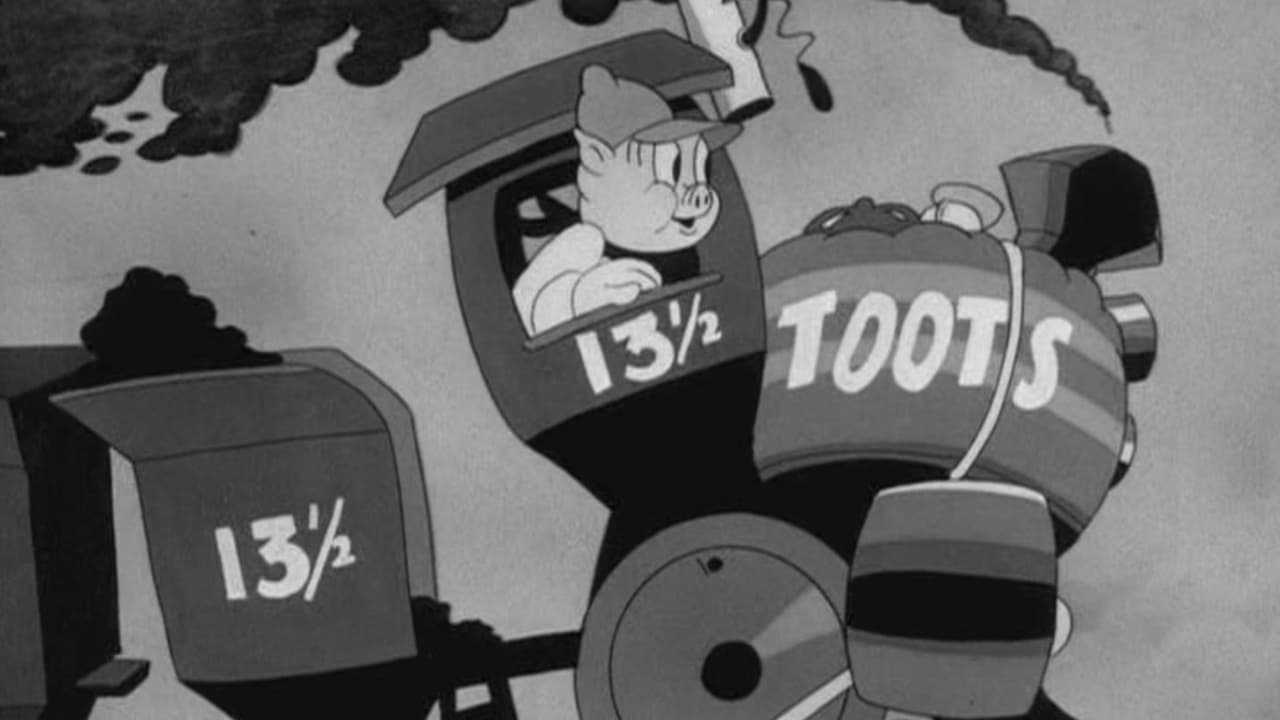

One of the many cartoons from the days when Porky Pig was the top Warner Bros. cartoon star - though Daffy Duck would soon overtake him - "Porky's Railroad" looks to me like a parable of many American's hopes during the Depression. We see how Porky is the simple little guy with his ordinary train going about things as he's always done, but he gets replaced by a big guy, much like how the banks foreclosed on many people's homes during those years. So, Porky's only hope is to race the big galoot: he's the underdog against seemingly improbable odds.Of course, I just might be reading too far into this cartoon. I don't know what specifically director Frank Tashlin wanted to say here; he may have just intended it as a way to pass time. Whatever the gist is, it's still a pretty enjoyable cartoon. Not their best by any stretch, but worth seeing.
... View MoreThis cartoon is another "my old (fill in the blank) can beat your new (fill in the blank)" plot, in the vein of John Henry versus the mechanical drill. Because I want to discuss some of the details of this short, this is a spoiler warning: This is an interesting little short, though there's very little that's all that special, save for Frank Tashlin using some tricks usually reserved for live-action film rather than cartoons. This is about a race, between Porky and a bully, with Porky using an old, broken-down old engine on its last wheels against a modern locomotive. As Porky is the hero in this picture, it's fairly apparent who will win in the end, but the gags make an obvious trip a fun and scenic journey.Along the way, there are quite a few sight gags, including one which kept the short from being seen in its entirety for quite a while. A bull has a strong supporting role in a couple of scenes and has a hand (or rather, a couple of horns) in the final outcome of the race.This short is available on the Looney Tunes Golden Collection, Volume 4 and is well worth seeing. Recommended.
... View MoreThis is a very good cartoon that I intend to watch many times more in the future, but for now I will publish these modest comments based on my experience of having seen it only once. What strikes me as shocking about 'Porky's Railroad' is its absolutely -- even brutally, I should say -- honest depiction of the soul of man under capitalism -- to paraphrase the title of that famous book by Oscar Wilde -- which I unfortunately have not read yet. The first shot establishes the state-of-the-art in trains -- one that would look modern even by today's standards. Then, the film switches to Porky's obsolete -- and barely functional -- model. It is interesting then how the film establishes Porky's character as sentimentally attached to his old train, but not anti-technology at all: for him, machines have precedence over animals. The race that ensues is the necessary conflict that precedes the shocking -- and of an unbridled cynicism -- ending that carries to the last consequences the truism that sentimentality has no place in a technological capitalist society -- Porky wins the race but is not allowed to keep his train; instead he is promoted to machinist of the new one, and is soon bursting with joy. Obsolescence happens to trains as well as to people -- the old machinist goes to the 'garbage can' just as Porky's old train.
... View MoreClearly this cartoon has been around a long time, produced prior to my birth. However in about 1997 I had an occasion to be viewing this piece in the company of several small children. In the midst of this viewing, I caught what I detected to be Morse code signals. I wasn't sure at first but as I carefully listened to this piece (on VHS tape), the more I was convinced that I was right. The problem was complicated because the Morse was somewhat hidden beneath a rendering of "California Here I Come." Nevertheless, taking time to be sure, I found that the real message was different from the message being show to those in a theater watching the cartoon. In the picture Porky, in a race against a new and modern train, was alerted by telegraph that a cow was on the tracks ahead. To convey this message to the film watching audience, a hand came to the screen taping a message on a telegraph key. There was this Morse code sound and the audience would have assumed the sound was a representation of a message to Porky that he should be careful. However the real message of the code was an invitation to contact the producer in Hollywood and receive a picture of Porky. At this late date it is fair to say that there is no way to know if anyone ever did this. In the days when this cartoon was being viewed by the theater going public, few in the audience would have had the opportunity to get a copy of this and go over it many times to weed out the truth of the hidden message. This didn't really become easily available to the general public until the development of VHS tapes. I view this as a simple little joke by the cartoon producers who probably had a long laugh in their offices for many years. A similar Morse code message can be found in The Lone Stranger and Porky produced in '39. Were it not for my skill at Morse, acquired as a condition of being a ham radio operator, this hidden message would probably never have come to my attention. I have no reason to think I was the first to note this message. Nevertheless it was an interesting experience to discover something few others would have noticed.
... View More